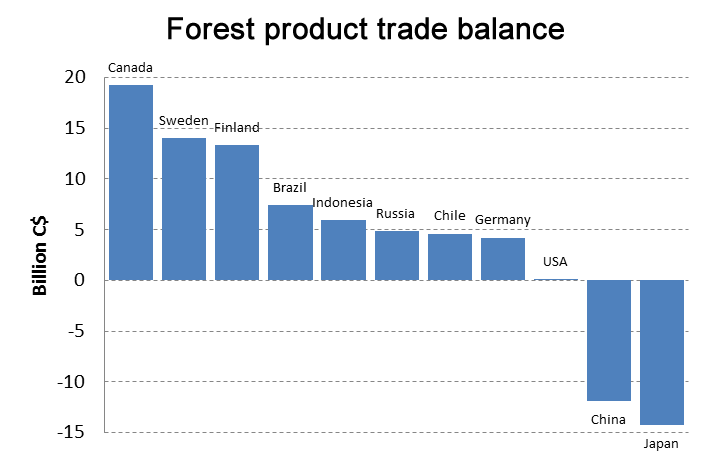The U.S. and Western Europe have long been the major markets for Canadian forest products. In recent years, however, Canada has been transforming its export markets by building on the strength of the sector’s traditional high quality wood fibre products. Today, for example, China and other Asian countries have become increasingly significant new markets for these products. This has helped offset the declines seen in traditional markets over recent years.

The benefits of wood in building construction. Duration: 2:07
Natural Resources Canada, through its Expanding Market Opportunities Program and the North American Wood First Program, is helping the country’s producers diversify and expand into emerging markets in Asia and Europe as well as into non-traditional markets in North America
Key exports
Canada’s forest products exports contribute $17.1 billion in net trade. Approximately 47% of total forest product export value is from the following three key products, each of which faces a different set of challenges and opportunities in today’s global markets.
- Northern bleached softwood kraft pulp (NBSK) – Canada has the largest share of the global NBSK market. That share represents almost one-third of world production and three-quarters of total NBSK capacity in North America.
This is a healthy position to have within the pulp market, as NBSK is an increasingly important pulp grade for paper and tissue production. However, the value of the Canadian dollar has a major impact on performance, given the global nature of this market. - Newsprint – World production of newsprint is approximately 32 million tonnes, and Canada is the single largest producer. It has a current production capacity of about 4 million tonnes, or 12% of the world total. However, demand for newsprint in North America has fallen by 65% since 2000. This collapse is the result of major structural changes in the marketplace, with electronic media having drastically reduced the demand for print advertising.
At the same time, the rising dollar has shifted Canadian mills from being the lowest cost producers in North America to being among the highest cost producers. Demand is not expected to recover to its previous high levels, but instead will likely stabilize over time at lower levels. - Softwood lumber – Canada is one of the world’s largest producers and exporters of softwood lumber. Softwood lumber accounts for 20% of the value of Canada’s forest product exports.
The largest export market for Canada is the U.S., where softwood lumber is used to build houses. When the U.S. housing bubble burst in 2006, demand for softwood lumber plummeted. High housing inventories, foreclosures and unemployment will continue to depress U.S. housing starts, and softwood lumber demand may not return to the normal levels of the past until 2015.

Engineered wood products. Duration: 2:01
Key destinations for forest products

- Domestic: The recent recession affected demand for solid wood products within Canada. However, Canada’s housing construction market has fared much better than that of many other countries, and is expected to remain an important source of demand for Canada’s forest sector.
- United States: The U.S. remains the most important market for Canada’s forest sector despite the impact of the housing market collapse and economic downturn in that country.
- China: Lumber exports to China have grown remarkably in recent years and are beginning to expand beyond low-grade timber to higher value products. Forest products associations and provincial agencies have partnered with the Canada Wood Export Program to develop Chinese demand for higher grade lumber. China’s demand for Canadian pulp has also been growing steadily since 2000, and now makes up 34% of total Canadian pulp exports.
- Japan: Japan is an important market for Canada. It is a significant consumer of high value wood products and of structural lumber for use in housing. Japanese demand for Canada’s products has weakened in recent years as a result of stagnant population growth and economy.
The Canada–U.S. Softwood Lumber Agreement is an important policy issue affecting forest products trade and competitiveness between Canada and the U.S. Cross-border disputes over Canadian exports of softwood lumber to the U.S. have gone on for many decades. Typically, these disputes have involved the U.S. imposing import duties or export charges.
Resolving the most recent dispute was a top trade priority for Canada, and in 2006 the two countries signed the Softwood Lumber Agreement. Under the agreement, U.S. countervailing and anti-dumping duty orders were fully withdrawn and the U.S. returned more than $5 billion (Canadian dollars) in duties to Canadian softwood lumber producers.
While disagreements continue over the interpretation of certain provisions of the Softwood Lumber Agreement, overall it has worked well and Canadian exporters have benefited from a stable trade environment. The agreement has been renewed for an additional two years, through 2015.
- Date Modified:
For further details log on website :
http://www.nrcan.gc.ca/node/13317

![[photo:] Damage from nun moth](https://www.nrs.fs.fed.us/disturbance/invasive_species/nun_moth/local-resources/images/damage_250.jpg) Lymantria monacha is considered to be the number one forest pest in Poland because of the unprecedented economic losses it causes in spite of intensive chemical protective treatments on an area of 6.3 million ha of pine, spruce and other conifers between 1978 and 1984 (Sliwa and Sierpinski, 1986). It is also considered to be a major pest in all the other areas where it goes through periodic outbreaks causing defoliation and resulting in the death of spruce and pine trees (Bejer 1988). The frequency of outbreaks has declined from about every 30-40 years to intervals of 6 years. It poses an ever present threat of being accidentally transported via commerce and introduced into other world areas where susceptible hosts are present for a couple of reasons: adults are readily attracted to artificial lights and have been observed in Russian Far East ports (Munson et al., 1995), and although eggs are normally laid in bark crevices, they also could be deposited in crevices on containers, pallets, ships, etc. In a pest risk assessment for importation of larch from Siberia into the United States, L. monacha was one of the serious pests that were considered at risk of introduction if the bark was still on the logs because of their use of the bark for oviposition and the fact that the eggs are not readily visible (Anonymous, 1991). Its establishment in areas with suitable hosts would be disastrous because of its polyphagous feeding habits, ability to colonize new habitats, and capacity to be spread rapidly by flying females.
Lymantria monacha is considered to be the number one forest pest in Poland because of the unprecedented economic losses it causes in spite of intensive chemical protective treatments on an area of 6.3 million ha of pine, spruce and other conifers between 1978 and 1984 (Sliwa and Sierpinski, 1986). It is also considered to be a major pest in all the other areas where it goes through periodic outbreaks causing defoliation and resulting in the death of spruce and pine trees (Bejer 1988). The frequency of outbreaks has declined from about every 30-40 years to intervals of 6 years. It poses an ever present threat of being accidentally transported via commerce and introduced into other world areas where susceptible hosts are present for a couple of reasons: adults are readily attracted to artificial lights and have been observed in Russian Far East ports (Munson et al., 1995), and although eggs are normally laid in bark crevices, they also could be deposited in crevices on containers, pallets, ships, etc. In a pest risk assessment for importation of larch from Siberia into the United States, L. monacha was one of the serious pests that were considered at risk of introduction if the bark was still on the logs because of their use of the bark for oviposition and the fact that the eggs are not readily visible (Anonymous, 1991). Its establishment in areas with suitable hosts would be disastrous because of its polyphagous feeding habits, ability to colonize new habitats, and capacity to be spread rapidly by flying females. ![[photo:] Nun moth larvae used to bioassay for Bt susceptibility](https://www.nrs.fs.fed.us/disturbance/invasive_species/nun_moth/local-resources/images/NM_DeepDish_250.jpg) Bacillus thuringiensis(Bt) products are available for operational use against Lymantria monacha in Eurasia. There is some variation in the control results obtained for different formulations but it has been used widely with good success in Germany, Russia, Belarus and Czech Republic. Information on the susceptibility of nun moth to the formulations available in the United States is needed to know what could be used to eradicate nun moth should it be introduced.
Bacillus thuringiensis(Bt) products are available for operational use against Lymantria monacha in Eurasia. There is some variation in the control results obtained for different formulations but it has been used widely with good success in Germany, Russia, Belarus and Czech Republic. Information on the susceptibility of nun moth to the formulations available in the United States is needed to know what could be used to eradicate nun moth should it be introduced.![[photo:] Large nun moth larva on conifer branch](https://www.nrs.fs.fed.us/disturbance/invasive_species/nun_moth/local-resources/images/large_larva_250.jpg) The parasitoids of Lymantria monacha in Europe have been catalogued and studied in detail by several people. The tachinid Parasetigena silvestris and the braconid Cotesia melanoscelus are considered to be the most important in Europe. Parasetigena agilis and Blepharipa schineri were shown to be the most effective parasites in the Russian Far East.
The parasitoids of Lymantria monacha in Europe have been catalogued and studied in detail by several people. The tachinid Parasetigena silvestris and the braconid Cotesia melanoscelus are considered to be the most important in Europe. Parasetigena agilis and Blepharipa schineri were shown to be the most effective parasites in the Russian Far East. ![[image:] Graph represents life cycle of nun moth in a laboratory setting on spruce foliage](https://www.nrs.fs.fed.us/disturbance/invasive_species/nun_moth/local-resources/images/phenology_graph_250.gif)




